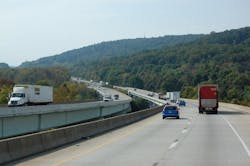PHILADELPHIA. Helping the trucking industry better manage the “real life experiences” affecting its operations in the here and now is going to be a near-term driving force for technological development, according to Dan Popkin, senior vice president of enterprise solutions for ALK Technologies, which is a subsidiary of Trimble.
And while bigger and more disruptive technologies are facing the industry down the road, Popkin feels this near-term focus will be critical to help the industry become safer and more efficient – especially in the face of the eroding quality of U.S. highway infrastructure.
“What we at ALK are most concerned about right now is real life experience; that human drivers matter far more than the machines that will be doing pieces of their work in the future,” he explained during a presentation here at ALK’s annual user conference.
From his perspective, there are several key “categories of core issues” that matter to business and the trucking industry today.
The first is truck driver and motorist safety, with Popkin noting that there are 1,800 truck rollovers per year, with 60% involving fatalities and the majority occurring on dry, straight roads.
“And two-thirds of the truck drivers involved [in those rollovers] are veterans with 10 years or more of experience,” he stressed. “So we are trying to mine real-time logistics data to present warnings to drivers.”The next is the impact of weather on roadway safety. “Of the 5.748 million accidents that occurred in the U.S. last year, 22% were weather-related, leading to 6,000 fatalities and 445,000 injuries,” Popkin said. “So now we’re trying to project road conditions out 12 hours [ahead] on routes to get insight what drivers might be potentially facing on the routes they are assigned.”
Improving efficiency and productivity, of course, remain critical to trucking and Popkin cited a 2015 white paper compiled by J.B. Hunt Transportation Services that indicated truck drivers spend an average of 108 minutes per day at shipper and receiver facilities, outside of arrival and departure check in.
“If we can free up just 30 minutes at the shipper and 30 minutes at the receiver, that gives them back an hour of time per day for driving,” Popkin explained. “An extra hour per day is an extra 50 miles per day or 12,500 extra miles per year. So creating more flexible pickup and delivery times can help increase productivity.”
He added that it’s another example of why optimizing existing trucking capacity as much as possible is so important. “The Hunt study showed the huge ramifications of just gaining an extra hour back for driving,” he stressed.To aid in that effort, he noted that ALK is looking at the ability to create “street maps” within freight yards, to help optimize freight flows within them.
Popkin also noted that inadequate infrastructure is restricting freight efficiency as well, as: 9.6% of U.S. bridges are deficient and 11.3% of bridges had their load limits reduced.
He also indicated that so much data is being collected now about the U.S. roadway systems that “it is virtually impossible” for a single map provider to process it all in real-time.
That’s why ALK is looking at the possible use of crowdsourcing to improve real-time mapping connections; to leverage customer data to do a better job of creating routes and do it faster as well.
But it’s not without pitfalls, he stressed. “There is great potential but the data must be moderated and verified – there are issues with data vandalism,” Popkin noted.
Finally, he touched on what he believes are the top three “exciting technologies” that stand out amongst all the others in terms of future impact upon trucking: autonomous trucks, drones, and truck platooning.
Yet each also comes with serious challenges, as well:
- Autonomous trucks: though the technology is rapidly evolving there are significant legal hurdles to overcome. The least of them is Google’s lawsuit against Uber. Still, despite those hurdles, it’s still anticipated that autonomous trucks will arrive within a 10-year timeframe.
- Drones: “They are everywhere,” said Popkin and the FAA said it expects seven million will be in the sky very soon, with some $2 billion already invested in this technology by the end of 2016. “Drones are real and here to stay. They offer great commercial potential but there are practical limitations to them,” he stressed. For starters, there are serious issues with privacy laws in terms of drone overflights. Next, of the 120 deliveries DHL has made with them, they’ve only been in two Swiss towns with speeds limited to 45 mph and a 20 lb. weight restriction.
- Platooning: Critics complain that there will be no impact on the driver shortage by platooning trucks and that the technology is too complex and too difficult in terms of getting different motor carriers or fleets and owner-operators to participate together in platoons.
“We don’t call into the question the massive impact those three trends will have on transportation,” Popkin stressed. “But the real impact from them will be far from immediate.”





